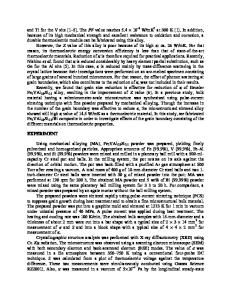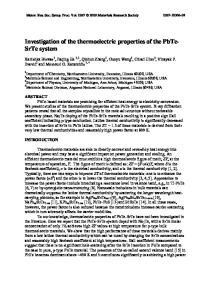Effects of the Addition of Rhenium on the Thermoelectric Properties of the AlPdMn Quasicrystalline System
- PDF / 117,081 Bytes
- 8 Pages / 612 x 792 pts (letter) Page_size
- 47 Downloads / 357 Views
Effects of the Addition of Rhenium on the Thermoelectric Properties of the AlPdMn Quasicrystalline System 1
2
3
1
4
A. L. POPE , R. GAGNON , R. SCHNEIDMILLER , P. N. ALBONI , R. T. LITTLETON IV , 1 1 1,4 2 3,4 B. ZAWILSKI , D. WINKLER , T. M. TRITT , J. STROM-OLSEN , J. KOLIS , S. 2 LEGAULT 1. Department of Physics and Astronomy, Clemson University, Clemson, SC 29634 USA 2. McGill University, Montreal, Canada 3. Department of Chemistry, Clemson University, Clemson, SC 29634 USA 4. Materials Science Department, Clemson University, Clemson, SC 29634 USA ABSTRACT Partially due to their lack of periodic structure, quasicrystals have inherently low thermal conductivity on the order of 1 - 3 W/m-K. AlPdMn quasicrystals exhibit favorable room -1 temperature values of electrical conductivity, 500-800 (Ω-cm) , and thermopower, 80 µV/K, with respect to thermoelectric applications. In an effort to further increase the thermopower and hopefully minimize the thermal conductivity via phonon scattering, quartenary Al71Pd21Mn8XReX quasicrystals were grown. X-ray data confirms that the addition of a fourth element does not alter the quasiperiodicity of the sample. Al71Pd21Mn8-XReX quasicrystals of varying Re concentration were synthesized where x had values of 0, 0.08, 0.25, 0.4, 0.8, 2, 5, 6, and 8. Both thermal and electrical transport property measurements have been performed and are reported. INTRODUCTION 1
Schlectmann and co-workers first discovered Quasicrystals in the early 1980’s. Recently they have been investigated for many applications due to their “forbidden” rotational 2 symmetry. Quasicrystals may be viewed as being structurally ordered but electronically they behave in a manner similar to that of amorphous materials. The structure of these materials has been extensively studied and only recently have large, stable quasicrystals been synthesized. With the synthesis of these materials, thermal and electrical transport of this unique class of materials has been studied. Quasicrystals exhibit electrical transport properties between those of a glass and a semi-metal. Thermal conductivity in these samples is similar to that of a glass (on the order of 1-3 W/m-K at room temperature), and is observed to remain low despite changes in composition or growth conditions. With inherently low thermal conductivity and favorable electrical transport, quasicrystals have the attributes of Glen Slack’s “Phonon-Glass, Electron3 Crystal” description of a good thermoelectric material. Quasicrystals exhibit a resistivity behavior that is typical of a semi-metal or in which semimetal-insulator transitions are prevalent (ρ ≈ 1-100 Ω-cm; resistivity can be much higher for 4
the AlPdRe system). The electrical resistivity in these systems is observed to increase as the quasicrystalline perfection increases, contrary to Matthiessen’s rule (ρ = ρPHONONS + ρIMPURITIES +
Z5.1.1
5
ρDEFECTS). With increasing temperature the electrical resistivity decreases, and through the addition of impurities and defects a method for tuning the electrical
Data Loading...










